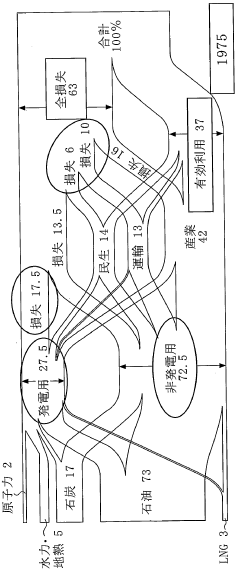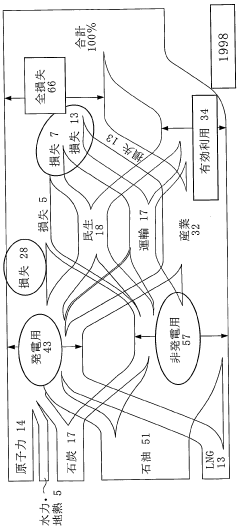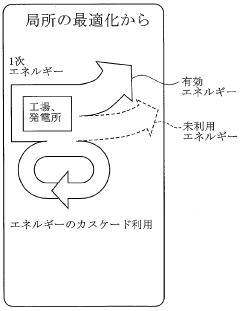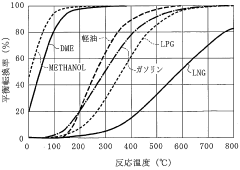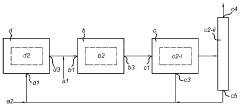Creating Synergy: Integrating Dimethyl Ether in Energy Ecosystems
JUL 1, 20259 MIN READ
Generate Your Research Report Instantly with AI Agent
Patsnap Eureka helps you evaluate technical feasibility & market potential.
DME Integration Goals
The integration of Dimethyl Ether (DME) into energy ecosystems represents a significant opportunity to enhance energy efficiency, reduce environmental impact, and diversify fuel sources. The primary goal of DME integration is to establish a sustainable and versatile energy carrier that can complement existing energy systems while addressing current challenges in the energy sector.
One of the key objectives is to leverage DME's potential as a clean-burning, high-cetane fuel for diesel engines. By integrating DME into transportation fuel systems, we aim to reduce particulate matter and NOx emissions, contributing to improved air quality in urban areas. This aligns with increasingly stringent environmental regulations and the global push towards cleaner energy solutions.
Another critical goal is to utilize DME as a bridge fuel in the transition towards renewable energy sources. DME can be produced from various feedstocks, including natural gas, coal, and biomass, making it a flexible option for different regions and energy landscapes. The integration of DME production with renewable energy sources, such as wind or solar power, presents an opportunity to create a more sustainable energy ecosystem.
In the industrial sector, DME integration aims to provide an alternative fuel source for heating and power generation. This diversification can enhance energy security and reduce dependence on traditional fossil fuels. Additionally, the goal is to explore DME's potential as a chemical feedstock, opening up new avenues for industrial applications and potentially creating synergies between energy and chemical production processes.
A crucial objective in DME integration is to develop and optimize the necessary infrastructure for production, distribution, and end-use applications. This includes adapting existing pipelines and storage facilities, as well as developing new, dedicated systems for DME handling. The goal is to create a seamless integration with current energy infrastructure while minimizing additional costs and disruptions.
Furthermore, DME integration aims to stimulate technological innovation in energy conversion and storage. By encouraging research and development in DME-related technologies, we seek to improve production efficiencies, enhance engine performance, and explore novel applications. This innovation-driven approach is essential for maintaining competitiveness in the rapidly evolving energy landscape.
Lastly, a significant goal of DME integration is to foster international cooperation and knowledge sharing. By collaborating on standards, best practices, and technological advancements, we can accelerate the global adoption of DME as a viable energy solution. This collaborative approach is crucial for addressing common challenges and maximizing the potential benefits of DME integration across diverse energy ecosystems worldwide.
One of the key objectives is to leverage DME's potential as a clean-burning, high-cetane fuel for diesel engines. By integrating DME into transportation fuel systems, we aim to reduce particulate matter and NOx emissions, contributing to improved air quality in urban areas. This aligns with increasingly stringent environmental regulations and the global push towards cleaner energy solutions.
Another critical goal is to utilize DME as a bridge fuel in the transition towards renewable energy sources. DME can be produced from various feedstocks, including natural gas, coal, and biomass, making it a flexible option for different regions and energy landscapes. The integration of DME production with renewable energy sources, such as wind or solar power, presents an opportunity to create a more sustainable energy ecosystem.
In the industrial sector, DME integration aims to provide an alternative fuel source for heating and power generation. This diversification can enhance energy security and reduce dependence on traditional fossil fuels. Additionally, the goal is to explore DME's potential as a chemical feedstock, opening up new avenues for industrial applications and potentially creating synergies between energy and chemical production processes.
A crucial objective in DME integration is to develop and optimize the necessary infrastructure for production, distribution, and end-use applications. This includes adapting existing pipelines and storage facilities, as well as developing new, dedicated systems for DME handling. The goal is to create a seamless integration with current energy infrastructure while minimizing additional costs and disruptions.
Furthermore, DME integration aims to stimulate technological innovation in energy conversion and storage. By encouraging research and development in DME-related technologies, we seek to improve production efficiencies, enhance engine performance, and explore novel applications. This innovation-driven approach is essential for maintaining competitiveness in the rapidly evolving energy landscape.
Lastly, a significant goal of DME integration is to foster international cooperation and knowledge sharing. By collaborating on standards, best practices, and technological advancements, we can accelerate the global adoption of DME as a viable energy solution. This collaborative approach is crucial for addressing common challenges and maximizing the potential benefits of DME integration across diverse energy ecosystems worldwide.
DME Market Analysis
The global market for dimethyl ether (DME) has been experiencing steady growth, driven by increasing demand for clean-burning alternative fuels and the chemical's versatility in various applications. As of 2021, the DME market was valued at approximately $5.5 billion, with projections indicating a compound annual growth rate (CAGR) of 10.8% from 2022 to 2030. This growth trajectory is underpinned by several key factors that are shaping the market landscape.
One of the primary drivers of DME market expansion is the growing emphasis on reducing greenhouse gas emissions and improving air quality. DME's clean-burning properties make it an attractive alternative to conventional diesel fuel, particularly in the transportation sector. Countries with stringent emissions regulations, such as China and several European nations, are at the forefront of adopting DME as a fuel substitute. This trend is expected to continue, with more regions likely to follow suit in the coming years.
The chemical industry represents another significant market for DME, where it serves as a crucial intermediate in the production of various chemicals, including methyl acetate, dimethyl sulfate, and acetic acid. The increasing demand for these downstream products, particularly in emerging economies, is contributing to the overall growth of the DME market.
Geographically, Asia-Pacific dominates the global DME market, accounting for over 60% of the total consumption. China, in particular, has been a key player, with substantial investments in DME production facilities and a strong push for its use as an alternative fuel. Europe and North America are also witnessing growing interest in DME, primarily driven by environmental concerns and the search for sustainable energy solutions.
Despite the positive outlook, the DME market faces certain challenges. The availability and cost of feedstock, primarily methanol, can significantly impact DME production economics. Additionally, the lack of widespread infrastructure for DME distribution and use, especially in the transportation sector, remains a barrier to more rapid market penetration.
Looking ahead, technological advancements in DME production, particularly in bio-based and waste-to-DME processes, are expected to open new avenues for market growth. These innovations could potentially address feedstock concerns and further enhance DME's environmental credentials. Moreover, the integration of DME into existing energy ecosystems, such as its use in power generation and as a cooking fuel in developing countries, presents significant opportunities for market expansion.
One of the primary drivers of DME market expansion is the growing emphasis on reducing greenhouse gas emissions and improving air quality. DME's clean-burning properties make it an attractive alternative to conventional diesel fuel, particularly in the transportation sector. Countries with stringent emissions regulations, such as China and several European nations, are at the forefront of adopting DME as a fuel substitute. This trend is expected to continue, with more regions likely to follow suit in the coming years.
The chemical industry represents another significant market for DME, where it serves as a crucial intermediate in the production of various chemicals, including methyl acetate, dimethyl sulfate, and acetic acid. The increasing demand for these downstream products, particularly in emerging economies, is contributing to the overall growth of the DME market.
Geographically, Asia-Pacific dominates the global DME market, accounting for over 60% of the total consumption. China, in particular, has been a key player, with substantial investments in DME production facilities and a strong push for its use as an alternative fuel. Europe and North America are also witnessing growing interest in DME, primarily driven by environmental concerns and the search for sustainable energy solutions.
Despite the positive outlook, the DME market faces certain challenges. The availability and cost of feedstock, primarily methanol, can significantly impact DME production economics. Additionally, the lack of widespread infrastructure for DME distribution and use, especially in the transportation sector, remains a barrier to more rapid market penetration.
Looking ahead, technological advancements in DME production, particularly in bio-based and waste-to-DME processes, are expected to open new avenues for market growth. These innovations could potentially address feedstock concerns and further enhance DME's environmental credentials. Moreover, the integration of DME into existing energy ecosystems, such as its use in power generation and as a cooking fuel in developing countries, presents significant opportunities for market expansion.
DME Tech Challenges
The integration of Dimethyl Ether (DME) into energy ecosystems presents several significant technical challenges that need to be addressed for successful implementation. One of the primary obstacles is the lack of widespread infrastructure for DME production, storage, and distribution. Unlike conventional fuels, DME requires specialized handling and storage facilities due to its unique physical properties, including its low boiling point and high vapor pressure.
Another major challenge lies in the optimization of DME production processes. While DME can be synthesized from various feedstocks, including natural gas, coal, and biomass, each production pathway has its own set of technical hurdles. For instance, the conversion efficiency from syngas to DME needs improvement to make the process more economically viable. Additionally, the purification of DME to meet fuel-grade standards presents technical difficulties, particularly in removing trace contaminants that could affect engine performance.
Engine compatibility poses a significant technical challenge for DME integration. Existing diesel engines require modifications to accommodate DME's different combustion characteristics and lower energy density compared to conventional diesel fuel. These modifications include changes to fuel injection systems, seals, and gaskets to prevent leakage and ensure optimal performance. Furthermore, the development of dedicated DME engines that can fully exploit the fuel's properties is still in its early stages.
The issue of DME's lower energy density compared to conventional fuels also presents challenges in terms of vehicle range and storage capacity. This necessitates larger fuel tanks or more frequent refueling, which can be a barrier to adoption, especially in the transportation sector. Addressing this challenge requires advancements in storage technology and improvements in engine efficiency to maximize the energy utilization of DME.
Environmental considerations also present technical challenges. While DME combustion produces lower emissions of particulate matter and nitrogen oxides compared to diesel, there are concerns about potential increases in formaldehyde emissions. Developing effective catalytic converters and emission control systems specifically tailored for DME-fueled engines is crucial to ensure compliance with increasingly stringent environmental regulations.
Lastly, the integration of DME into existing energy systems requires overcoming compatibility issues with current infrastructure. This includes adapting pipelines, storage facilities, and fueling stations to handle DME safely and efficiently. The development of cost-effective and reliable DME-compatible materials for seals, gaskets, and other components is essential to prevent leakage and ensure long-term durability of the infrastructure.
Another major challenge lies in the optimization of DME production processes. While DME can be synthesized from various feedstocks, including natural gas, coal, and biomass, each production pathway has its own set of technical hurdles. For instance, the conversion efficiency from syngas to DME needs improvement to make the process more economically viable. Additionally, the purification of DME to meet fuel-grade standards presents technical difficulties, particularly in removing trace contaminants that could affect engine performance.
Engine compatibility poses a significant technical challenge for DME integration. Existing diesel engines require modifications to accommodate DME's different combustion characteristics and lower energy density compared to conventional diesel fuel. These modifications include changes to fuel injection systems, seals, and gaskets to prevent leakage and ensure optimal performance. Furthermore, the development of dedicated DME engines that can fully exploit the fuel's properties is still in its early stages.
The issue of DME's lower energy density compared to conventional fuels also presents challenges in terms of vehicle range and storage capacity. This necessitates larger fuel tanks or more frequent refueling, which can be a barrier to adoption, especially in the transportation sector. Addressing this challenge requires advancements in storage technology and improvements in engine efficiency to maximize the energy utilization of DME.
Environmental considerations also present technical challenges. While DME combustion produces lower emissions of particulate matter and nitrogen oxides compared to diesel, there are concerns about potential increases in formaldehyde emissions. Developing effective catalytic converters and emission control systems specifically tailored for DME-fueled engines is crucial to ensure compliance with increasingly stringent environmental regulations.
Lastly, the integration of DME into existing energy systems requires overcoming compatibility issues with current infrastructure. This includes adapting pipelines, storage facilities, and fueling stations to handle DME safely and efficiently. The development of cost-effective and reliable DME-compatible materials for seals, gaskets, and other components is essential to prevent leakage and ensure long-term durability of the infrastructure.
DME Integration Methods
01 Dimethyl ether as a synergistic component in fuel compositions
Dimethyl ether (DME) can be used as a synergistic component in fuel compositions, particularly in diesel fuel blends. The addition of DME to conventional fuels can improve combustion efficiency, reduce emissions, and enhance overall engine performance. This synergy is attributed to DME's high cetane number and oxygen content, which promote cleaner and more complete combustion.- Dimethyl ether production from syngas: Methods for producing dimethyl ether from synthesis gas (syngas) using catalysts. These processes often involve the conversion of syngas to methanol and subsequent dehydration to dimethyl ether, or direct conversion of syngas to dimethyl ether. The synergy between catalyst components and reaction conditions is crucial for optimizing yield and selectivity.
- Catalyst systems for dimethyl ether synthesis: Development of novel catalyst systems that enhance the synergistic effects in dimethyl ether production. These catalysts often combine methanol synthesis and dehydration functions, improving efficiency and selectivity. Research focuses on optimizing catalyst composition, structure, and preparation methods to maximize dimethyl ether yield.
- Process integration and energy efficiency: Innovative approaches to integrate dimethyl ether production with other processes, enhancing overall energy efficiency and reducing costs. This includes heat integration, co-production of valuable by-products, and utilization of waste streams. The synergy between different process units is exploited to improve the economic viability of dimethyl ether production.
- Dimethyl ether as a fuel additive or alternative fuel: Exploration of dimethyl ether's potential as a fuel additive or alternative fuel, particularly in diesel engines. Research focuses on the synergistic effects of blending dimethyl ether with conventional fuels, its impact on engine performance, emissions reduction, and compatibility with existing infrastructure.
- Dimethyl ether in chemical synthesis: Utilization of dimethyl ether as a reactant or intermediate in various chemical synthesis processes. The synergistic effects of dimethyl ether with other reagents or catalysts are explored to develop new reaction pathways, improve yields, or create novel products in fields such as pharmaceuticals, polymers, and fine chemicals.
02 Catalytic processes for dimethyl ether production
Various catalytic processes have been developed to produce dimethyl ether efficiently. These processes often involve the use of specific catalysts or catalyst combinations that promote the conversion of synthesis gas or methanol to DME. The synergistic effects between different catalysts or catalyst components can significantly improve DME yield and selectivity.Expand Specific Solutions03 Dimethyl ether in chemical synthesis
Dimethyl ether exhibits synergistic effects when used as a reactant or solvent in various chemical synthesis processes. Its unique properties, such as polarity and low boiling point, make it valuable in reactions where it can enhance reaction rates, improve selectivity, or facilitate product separation. This synergy is particularly notable in certain organic synthesis and petrochemical processes.Expand Specific Solutions04 Dimethyl ether in refrigeration and heat transfer applications
The use of dimethyl ether in refrigeration and heat transfer systems has shown synergistic benefits. When combined with other refrigerants or working fluids, DME can enhance the overall performance of cooling systems. Its thermodynamic properties contribute to improved energy efficiency and environmental friendliness in these applications.Expand Specific Solutions05 Dimethyl ether in polymer processing and materials science
Dimethyl ether has demonstrated synergistic effects in polymer processing and materials science applications. It can act as a blowing agent, plasticizer, or solvent in various polymer systems, enhancing material properties or processing characteristics. The combination of DME with other additives or processing aids can lead to improved product quality or manufacturing efficiency in the plastics and materials industries.Expand Specific Solutions
DME Industry Players
The integration of Dimethyl Ether (DME) in energy ecosystems is gaining traction, with the market in an early growth phase. Major players like China Petroleum & Chemical Corp., DuPont, and BASF are investing in research and development, indicating increasing technological maturity. The market size is expanding, driven by the growing demand for cleaner energy alternatives. Companies such as ExxonMobil and Indian Oil Corp. are exploring DME's potential in various applications, from transportation fuels to industrial processes. Universities and research institutions, including the University of Southern California and Taiyuan University of Technology, are contributing to technological advancements, further accelerating the industry's development and competitiveness.
China Petroleum & Chemical Corp.
Technical Solution: China Petroleum & Chemical Corp. (Sinopec) has developed an innovative approach to integrating dimethyl ether (DME) into energy ecosystems. Their technology focuses on the production of DME from syngas derived from coal and natural gas. Sinopec has implemented a large-scale DME production facility with an annual capacity of 1 million tons[1]. The process involves gasification of coal or reforming of natural gas to produce syngas, followed by methanol synthesis and subsequent dehydration to DME. Sinopec has also developed a novel catalyst system that improves DME yield and selectivity, achieving conversion rates of up to 85%[2]. Additionally, they have invested in DME distribution infrastructure, including dedicated storage facilities and modified fuel stations to support DME as a clean alternative fuel for vehicles and household cooking[3].
Strengths: Large-scale production capability, integrated supply chain from feedstock to end-use, and advanced catalyst technology. Weaknesses: Dependence on coal as a primary feedstock may limit environmental benefits, and the need for significant infrastructure modifications for widespread adoption.
DuPont de Nemours, Inc.
Technical Solution: DuPont has developed a proprietary process for DME production that focuses on sustainability and efficiency. Their approach utilizes biomass feedstocks, particularly lignocellulosic materials, to produce DME through a two-step process. First, the biomass is gasified to produce syngas, which is then converted to DME using a novel bifunctional catalyst[4]. This catalyst combines methanol synthesis and dehydration functions, allowing for direct DME synthesis from syngas in a single reactor, reducing capital and operating costs. DuPont's process achieves carbon conversion efficiencies of up to 65% and can produce DME with a purity exceeding 99.5%[5]. The company has also developed specialized materials for DME handling and storage, including fluoropolymer linings for tanks and pipelines that resist the solvent properties of DME[6].
Strengths: Use of renewable feedstocks, innovative catalyst technology, and expertise in materials science for DME infrastructure. Weaknesses: Relatively lower production capacity compared to fossil fuel-based methods, and potential competition for biomass resources.
DME Core Innovations
Energy supply method and system
PatentWO2006004140A1
Innovation
- The introduction of Dimethyl Ether (DME) as a versatile energy circulation medium, which can be derived from biomass, waste, and petroleum residues, and used for power generation, transportation, and heating, allowing for efficient energy storage and distribution without relying on pipelines, and enabling the conversion of waste heat into usable energy.
Process and system for producing dimethyl ether
PatentActiveUS11897839B2
Innovation
- A process combining conventional DME synthesis with a separation-enhanced reverse water gas shift reaction, allowing for flexible feedstock composition and reducing the need for CO2 recycles by converting CO2 to CO, thereby improving yield and reducing costs.
DME Environmental Impact
The integration of Dimethyl Ether (DME) into energy ecosystems presents both opportunities and challenges from an environmental perspective. As a clean-burning, sulfur-free fuel, DME offers significant potential to reduce harmful emissions compared to conventional fossil fuels. When used in compression ignition engines, DME produces lower levels of particulate matter, nitrogen oxides, and carbon monoxide, contributing to improved air quality in urban areas.
Furthermore, DME can be produced from a variety of feedstocks, including renewable sources such as biomass and waste materials. This versatility allows for the development of more sustainable production pathways, potentially reducing the overall carbon footprint of the fuel lifecycle. The ability to produce DME from biogas or captured carbon dioxide also presents opportunities for carbon recycling and mitigation of greenhouse gas emissions.
However, the environmental impact of DME integration is not without complexities. The production process, particularly when derived from fossil fuels, can still contribute to carbon dioxide emissions. The energy intensity of DME production must be carefully considered to ensure that the environmental benefits of its use outweigh the impacts of its manufacture. Additionally, the large-scale adoption of DME would require significant infrastructure changes, which could have their own environmental implications.
Land use changes associated with biomass cultivation for DME production also warrant careful consideration. While utilizing waste biomass can be environmentally beneficial, dedicated energy crops may compete with food production or lead to deforestation if not managed sustainably. The water footprint of DME production, especially in water-stressed regions, is another factor that requires thorough assessment.
From a lifecycle perspective, the environmental impact of DME varies depending on the production pathway and end-use application. Studies have shown that DME can offer greenhouse gas emission reductions compared to conventional diesel fuel, particularly when produced from renewable sources. However, the extent of these benefits depends on factors such as feedstock choice, production efficiency, and transportation logistics.
As DME integration progresses, ongoing research and development efforts are focused on optimizing production processes to minimize environmental impacts. This includes exploring more efficient catalysts, improving heat integration in production facilities, and developing innovative carbon capture technologies. The potential for DME to serve as an energy storage medium for renewable electricity also presents opportunities for enhancing the overall sustainability of energy systems.
Furthermore, DME can be produced from a variety of feedstocks, including renewable sources such as biomass and waste materials. This versatility allows for the development of more sustainable production pathways, potentially reducing the overall carbon footprint of the fuel lifecycle. The ability to produce DME from biogas or captured carbon dioxide also presents opportunities for carbon recycling and mitigation of greenhouse gas emissions.
However, the environmental impact of DME integration is not without complexities. The production process, particularly when derived from fossil fuels, can still contribute to carbon dioxide emissions. The energy intensity of DME production must be carefully considered to ensure that the environmental benefits of its use outweigh the impacts of its manufacture. Additionally, the large-scale adoption of DME would require significant infrastructure changes, which could have their own environmental implications.
Land use changes associated with biomass cultivation for DME production also warrant careful consideration. While utilizing waste biomass can be environmentally beneficial, dedicated energy crops may compete with food production or lead to deforestation if not managed sustainably. The water footprint of DME production, especially in water-stressed regions, is another factor that requires thorough assessment.
From a lifecycle perspective, the environmental impact of DME varies depending on the production pathway and end-use application. Studies have shown that DME can offer greenhouse gas emission reductions compared to conventional diesel fuel, particularly when produced from renewable sources. However, the extent of these benefits depends on factors such as feedstock choice, production efficiency, and transportation logistics.
As DME integration progresses, ongoing research and development efforts are focused on optimizing production processes to minimize environmental impacts. This includes exploring more efficient catalysts, improving heat integration in production facilities, and developing innovative carbon capture technologies. The potential for DME to serve as an energy storage medium for renewable electricity also presents opportunities for enhancing the overall sustainability of energy systems.
DME Policy Landscape
The global policy landscape for dimethyl ether (DME) integration in energy ecosystems is evolving rapidly, reflecting the growing recognition of DME's potential as a clean and versatile energy carrier. Governments worldwide are implementing a range of policies to support DME adoption, with varying approaches based on national priorities and energy strategies.
In the European Union, the Renewable Energy Directive (RED II) has been a significant driver for DME development. This policy framework sets targets for renewable energy use in transportation and promotes the use of advanced biofuels, including DME produced from renewable sources. Several EU member states have introduced additional incentives, such as tax breaks and blending mandates, to encourage DME production and utilization.
China has emerged as a leader in DME policy support, with a strong focus on reducing air pollution and diversifying its energy mix. The Chinese government has implemented a series of policies to promote DME as a clean cooking fuel and transportation fuel alternative. These include subsidies for DME production facilities, mandates for DME use in specific sectors, and research funding for DME technology development.
In the United States, policy support for DME has been more fragmented, with initiatives primarily at the state level. California's Low Carbon Fuel Standard (LCFS) has been particularly influential, providing credits for low-carbon fuels including DME. This has incentivized DME production from renewable feedstocks and its use in heavy-duty vehicles.
Japan and South Korea have also shown interest in DME as part of their energy transition strategies. Both countries have implemented policies to support DME research and development, with a focus on its potential as a hydrogen carrier and its role in decarbonizing industrial processes.
Developing countries, particularly in Southeast Asia and Africa, are increasingly recognizing DME's potential to address energy access issues. Policies in these regions often focus on promoting DME as a clean cooking fuel alternative to traditional biomass, with some countries implementing subsidies and distribution programs to increase adoption.
International organizations play a crucial role in shaping the global DME policy landscape. The International Energy Agency (IEA) and the United Nations have highlighted DME's potential in various reports and policy recommendations, influencing national and regional policy decisions.
Despite these positive developments, challenges remain in creating a cohesive global policy framework for DME integration. Inconsistencies in regulations, varying levels of support across regions, and competition from other alternative fuels continue to impact DME's widespread adoption. As the urgency of climate action grows, policymakers are increasingly looking to harmonize approaches and create more comprehensive strategies for integrating DME into sustainable energy ecosystems.
In the European Union, the Renewable Energy Directive (RED II) has been a significant driver for DME development. This policy framework sets targets for renewable energy use in transportation and promotes the use of advanced biofuels, including DME produced from renewable sources. Several EU member states have introduced additional incentives, such as tax breaks and blending mandates, to encourage DME production and utilization.
China has emerged as a leader in DME policy support, with a strong focus on reducing air pollution and diversifying its energy mix. The Chinese government has implemented a series of policies to promote DME as a clean cooking fuel and transportation fuel alternative. These include subsidies for DME production facilities, mandates for DME use in specific sectors, and research funding for DME technology development.
In the United States, policy support for DME has been more fragmented, with initiatives primarily at the state level. California's Low Carbon Fuel Standard (LCFS) has been particularly influential, providing credits for low-carbon fuels including DME. This has incentivized DME production from renewable feedstocks and its use in heavy-duty vehicles.
Japan and South Korea have also shown interest in DME as part of their energy transition strategies. Both countries have implemented policies to support DME research and development, with a focus on its potential as a hydrogen carrier and its role in decarbonizing industrial processes.
Developing countries, particularly in Southeast Asia and Africa, are increasingly recognizing DME's potential to address energy access issues. Policies in these regions often focus on promoting DME as a clean cooking fuel alternative to traditional biomass, with some countries implementing subsidies and distribution programs to increase adoption.
International organizations play a crucial role in shaping the global DME policy landscape. The International Energy Agency (IEA) and the United Nations have highlighted DME's potential in various reports and policy recommendations, influencing national and regional policy decisions.
Despite these positive developments, challenges remain in creating a cohesive global policy framework for DME integration. Inconsistencies in regulations, varying levels of support across regions, and competition from other alternative fuels continue to impact DME's widespread adoption. As the urgency of climate action grows, policymakers are increasingly looking to harmonize approaches and create more comprehensive strategies for integrating DME into sustainable energy ecosystems.
Unlock deeper insights with Patsnap Eureka Quick Research — get a full tech report to explore trends and direct your research. Try now!
Generate Your Research Report Instantly with AI Agent
Supercharge your innovation with Patsnap Eureka AI Agent Platform!
